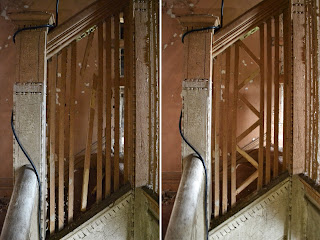Removing the northern addition will leave a large gap in the foundation. This gap will need to be infilled to support the new exterior wall above it, and retain the dirt that will backfill the other side. The partition walls in the basement are removed along with the stair (which will be shifted over to better fit the upstairs spaces).
The new concrete footing has to be poured on compacted soil. Using a gas-powered concrete saw, Tim cuts the existing concrete pad and flanking walls to make way for the new concrete footing.
A trench is dug large enough for our 12"x16" footing, plus some extra room for a perforated drain pipe and gravel to later be added along it. Formwork - to give the concrete the right size and shape - is made from scrap OSB from a nearby construction site. The drain pipe needs to enter the inside of the basement to connect to a sump crock, so it's run through the formwork prior to pouring. Finally, two long pieces of steel rebar are added to add some tensile strength.
The side walls are a little trickier. Most of this wall is only a very thin 1/4" layer of concrete meant to keep the dirt at bay, though the corner is poured solid. We break through the weak parts and dig out as best we can to be able to fill this with concrete and give us something fully solid to lay the block against. Because it's angled, we'll have to cut our blocks at an angle at that end.
Concrete trucks delivering to jobsites almost always finish with excess concrete. Sometimes this is taken back to their facilities and poured into forms to make concrete block. Often it is dumped, dried, crushed, and then used as aggregate in more concrete. After a few phone calls and well placed words with some local concrete companies, Modern Concrete agreed to divert some of that excess to us for free.
Not only does this save us a few hundred dollars, but also the painstaking labor of mixing about two tons of concrete bags by hand. The truck is able to pull up to the back door. The extended chute still falls a little short, so we improvise a secondary chute out of some corrugated plastic leftover from the Free City festival. From here, we pull the mixture to the other end with shovels, hoes, and anything else we can get our hands on.
The next 20 minutes are fervent, and what I think may be the best bonding experience between the Youth Build students and myself to date. Arms exhausted, shirts drenched in sweat, hands caked in grey goop - we struggle to keep up with the cement dumping out of the truck.
The surface is screeded and troweled, and vertical pieces of rebar are embedded at the ends and every 4'. These will bond the block wall to the footing. Next step: lay 400 concrete blocks.






















